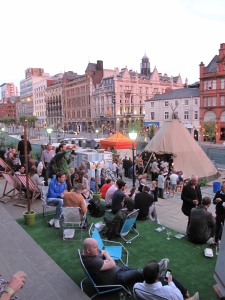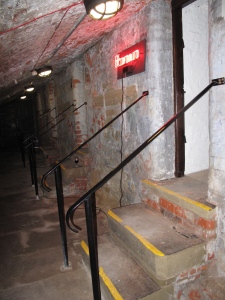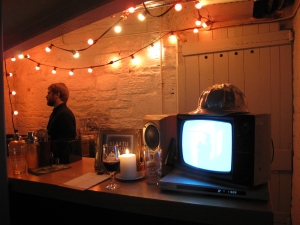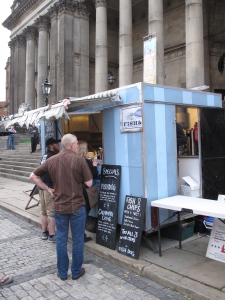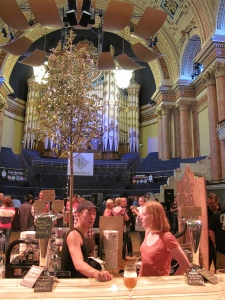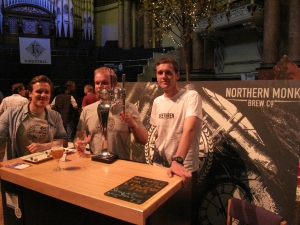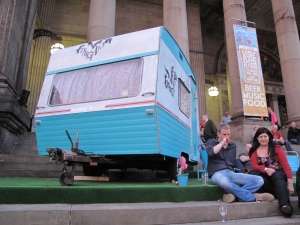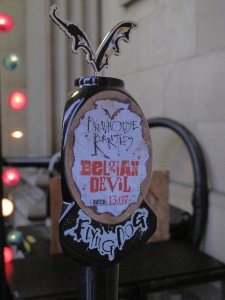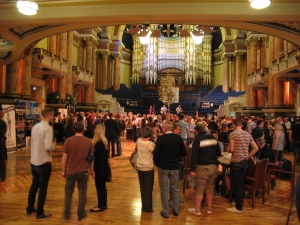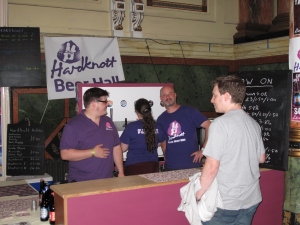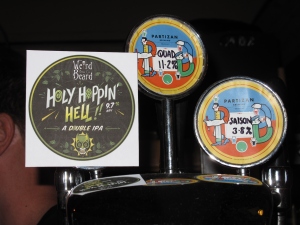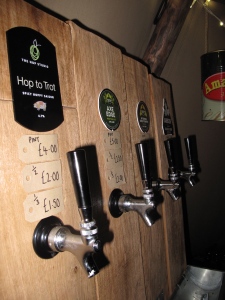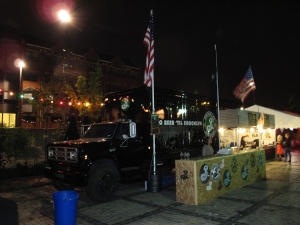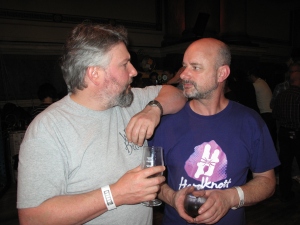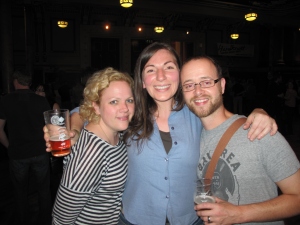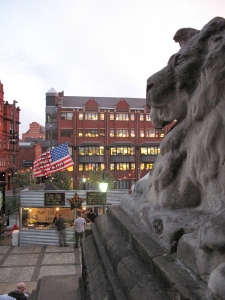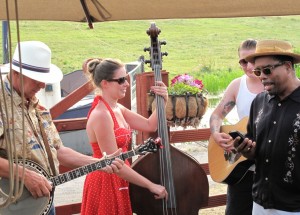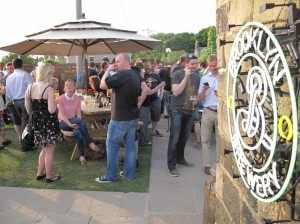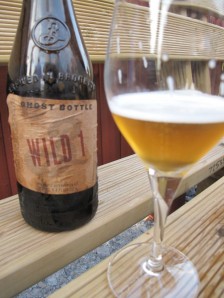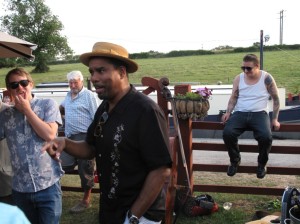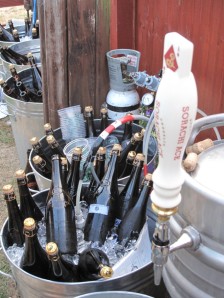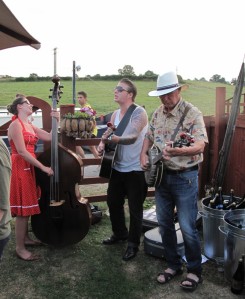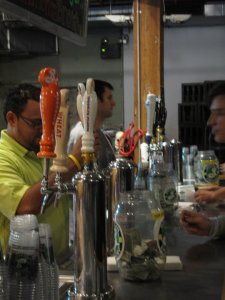Archive
Brooklyn Brewery Pop Up, 20-24 The Calls, Leeds City Centre
James Clay, importer of some of the best American, Belgian and German beers to the UK, have succeeded in an application for a licence to open a “pop up” Brooklyn Brewery bar in a warehouse on The Calls in central Leeds, despite police objections.
The bar will be in a currently empty warehouse at 20-24 The Calls, about 50 metres from BrewDog Leeds and 100 metres from The Stew & Oyster (Calls Landing). The licence application documents, which can be read here, show similar objections from the police as were made in the BrewDog licensing saga, to opening any new bar close to “an area which is an alcohol related crime hotspot, Call Lane” and the same “appreciation versus inebriation” arguments.
The Yorkshire Evening Post reports that representations were made to the sub-committee that the bar was to attract, “the well-behaved and “discerning” drinker, prepared to spend £7 or more on a pint of speciality beer“. A representative of the West Yorkshire Police stated that, “People with money still have the ability of causing trouble when inebriated.” Surely not.
The bar is stated to be temporary, although it is not clear for how long it is expected to operate. The licence is restricted to Wednesdays, Thursdays, Saturdays and Sundays. Interestingly, it was stated that the bar is “a temporary arts and cultural space used for the purpose of marketing“, that it is primarily an exercise in promoting the Brooklyn brand and may operate at a loss. However, at £7+ a pint I assume the loss won’t be made on the beer.
I’ll be interested to see how this pans out and whether the set-up will offer something different to the existing craft beer bars in Leeds. When I read about it, I initially thought of the regular Friday evening “happy hour” sessions held in the brewery in Williamsburg when we went there in 2010 (see photo), with picnic tables, plastic glasses, beer vouchers, pizzas delivered to the front door and ultraobscure beers. I assume that this new venture, “pop up” as it is, will seem a little more permanent, but who knows? Spit and sawdust can be pretty hip.
Market Forces: Dock Street Market, Leeds
Back in the mists of time, when everyone was on the previous version of the iPhone and the world was on tenterhooks waiting for Russell Crowe and Ridley Scott’s version of Robin Hood, there was a deli-come-grocery on the cobbled Dock Street in Leeds called Simpson’s. Simpson’s was quite expensive, but the young professionals of Brewery Wharf and Clarence Dock liked the fresh bread and the impressive selection of bottled ales, including Ilkley and Saltaire beers.
Simpsons closed, possibly due to competition from a cheap but souless Tesco Express that had recently opened, and there was due wailing and gnashing of teeth about the death of independent shops and quite a lot of discussions about whether it could be re-opened as a social enterprise. Of course no-one really knew what a “social enterprise” was, but that nice polite Mr Cameron seemed to be in favour of them, and anyone who didn’t really like the word “social” was in favour of “enterprise” and vice versa, so it seemed like a reasonably admirable idea at the time without really gripping anyone.
Ultimately, in November 2010, Dock Street Market opened on the site of Simpson’s, run by “a group of independent local food traders“. I think the line-up may have changed over time, but at the moment there seems to be a deli counter, a bakery and a bar. The bar currently sells cakes and Prohibition-chic “teapot cocktails”, which Kate enjoyed.
The fact that I was most interested in the selection of beer will not come as a surprise, but the selection itself might. As well as cask Black Sheep (it’s still Yorkshire after all, even if it is young, hip, waterfront Yorkshire) there was also Anchor Steam, BrewDog Punk IPA and Ilkley MJ Fortis on keg. The bottle selection was even more impressive, including Brooklyn Lager, BrewDog 5am Saint, Chimay Red, Orval and Anchor Old Foghorn.
I had a Goose Island Matilda, an Orvalalike which was initially surprisingly bretty, but later pleasingly so, followed by a De Struise Pannepot 2010, a darkly delicious but drinkable 10% spiced Belgian strong ale which really needs that bit of cake to soak it up.
As well as the beer selection, I was impressed by the relaxed atmosphere of Dock Street Market, which leaves it somewhere between a cafe, a bar and a common room; seemingly a successful third place. Its neighbours, the Leeds Brewery pub Pin and Mitchell and Butler’s Adelphi are another matter: Pin, whilst similarly having an impressive imported selection thanks to James Clay, can seem sadly quiet and has stripped down its food menu. The Adelphi, whilst being one of Leeds’ best food pubs and having a great historic interior, has had quite an unimpressive cask selection the last two times I’ve been in.
Dock Street Market, for seeming to have come together at random and for its Cath Kidston-esque bunting and cake stands, has nonetheless ended up being perhaps the best place for a beer in the area. They’re even planning a ticketed Anchor tap takeover/food and beer-matching dinner with Ben from James Clay on 6 June 2012, a US craft beer festival on 4 July 2012 and a BrewDog tap takeover on 1 August 2012, each of which is as good a reason as any to pay your first visit, if you haven’t already.
Beer in Copenhagen: Jacobsen Saaz Blonde in The Laundromat Cafe, Nørrebro
I mentioned in my last post that Copenhagen occasionally comes across as a utopia for Guardian-readers, but I think one of the best examples of the achingly hip chic is a cafe bar we went to by accident: The Laundromat Cafe in Nørrebro.
After Nørrebro Bryghus, we intended to go to Ølbaren on Elmegade. However it was a busy Friday night and we didn’t feel like standing, so we went for a nightcap to a cool-looking cafe we’d seen across the road.
The Laundromat Cafe is also actually a laundromat, although the four or so washing machines in the back were dormant at 10.30pm. However there were still a few people sitting around eating some appetising-looking burgers and so on.
Apart from the concept, the decor makes the cafe a wet dream for readers of the glossy supplements. One detail in particular stood out: bookshelves with paperbacks arranged by colour.
It’s not exactly a beer destination, but I recall that the menu had around 10-12 different bottled beers. Kate had a reliable Brooklyn East India Pale Ale whilst I had a Jacobsen Saaz Blonde. As I will hopefully get round to explaining in more detail in a future post, Jacobsen is basically Carlsberg’s version of the recently-popular macro-owned-craft/speciality beer brewery operating from the old brewery site in Copenhagen, whilst most production has been moved elsewhere.
Saaz Blonde is a 7.1% top-fermented blonde ale made with pilsner malts and Czech Saaz hops. I found it a pleasant Belgianish blonde with an unexpected amount of yeast flavour (I had expected a strong pilsner) up front followed by a moderate grassy/floral bitterness. I had hoped for a cleaner, punchier hit of Saaz, but it was a pleasant beer to enjoy at the end of the night nonetheless.
The Food Programme: The New Beer Frontier
I mentioned in my post regarding the Garrett Oliver lunch at Mr Foleys that there was a journalist from BBC Radio 4 present. The episode of The Food Programme that he recorded was broadcast today and will shortly be available on iPlayer here and also as a podcast from this page.
Whilst there are a couple of slight slip-ups and the odd oversimplification for those who are paying attention, it’s a wide-ranging and interesting programme, including contributions from Pete Brown, James Clay, Neil from Eating Isn’t Cheating, Rob from Hopzine and breweries such as Bristol Beer Factory and Camden Town in the UK and Harpoon and CBC in the US. It’s certainly one of the most up-to-date and least clichéd mainstream programmes I’ve heard about beer and a good recognition of the US craft influence on UK breweries.
Northern Sole: Imagining a life with only Northern English beers
The other night I was thinking about how many Northern English breweries consistently impress and surprise me, and how many of them are relatively new. Thornbridge Brewery seems like an established veteran of UK craft brewing, but it’s only seven years old. Marble Brewery is positively neolithic in comparison to most, having started in 1997.
It is trite to say that the new wave of breweries in the UK owe a lot to the American scene. However, the enjoyment with which I’ve been drinking hop-forward beers like Buxton Wild Boar, Summer Wine Diablo or Magic Rock High Wire makes me wonder if I even really need to buy American beers any more. Certainly these English beers haven’t acquired either the age or the price uplift of their imported American inspirations by the time they make it to my shopping basket.
Then I wondered whether I really needed to drink beers from anywhere else at all. Between them, Marble and Thornbridge have been working their way through the canon of Northern European beer styles recently, from Vienna lager through wheat beers to Kolsch, saisons, dubbels and tripels. Summer Wine have also paid tribute in their own irreverent way with the Lime & Coriander Saison I’m drinking right now and the mind-bending but superb double Belgian Rye PA Cohort. Sure, I’d miss Orval, but I could certainly attempt to console myself with Durham Brewery’s Bombay 106.
This is not to mention the excellent quality of both traditional English beer styles and those newer styles which, although influenced from abroad and made with New World hops, are nonetheless peculiarly British: the barley wines; the strong stouts and porters like Hawkshead Brodie’s Prime; the cask session pale ales like Roosters Yankee, Ilkley Mary Jane or Hawkshead Windermere Pale; and yes, even the brown bitters that sell by the gallon.
After a bit of thinking, looking at Google Maps and (frankly) gerrymandering, I concluded that, if it came to it, I could probably cope with drinking only beers brewed within a 75 mile radius of my house in North Leeds. Provided, of course, that they had access to hops flown from the other side of the world. (I should note I hadn’t even considered Burton and it ended up within the area quite by accident – I was pushing north east and north west). That would allow me to enjoy beers (inter alia) from all of the following breweries:
Acorn, Black Sheep, Buxton, Coniston, Cropton, Daleside, Durham, Goose Eye, Hambleton, Hardknott*, Hawkshead, Ilkley, Kelham Island, Kirkstall, Leeds, Little Valley, Liverpool Organic, Magic Rock, Mallinsons, Marble, Ossett, Red Willow, Revolutions, Ridgeside, Roosters, Saltaire, Sam Smiths, Stringers, Summer Wine, Thornbridge, Timothy Taylor, and York.
Whilst I would scrape by on these riches, in quiet moments I would find myself yearning for Orval, Brooklyn Lager, St Bernardus, Sierra Nevada Torpedo or even Jever. I’d certainly miss Kernel and Brewdog; it would sting on a positively existential level to never enjoy another Irish stout. The worst would be to travel and not enjoy local beers: cursed to stick to the Watney’s Red Barrel in “Majorcan bodegas selling fish and chips […] and calamares and two veg“.
But I think this exercise has helped me to realise that one of the best things about beer is that someone in the smallest unit of an industrial estate in West Yorkshire can buy foreign ingredients and build on the innovation and tradition of other brewers, cultures and traditions, to make the some of best beer in the world, right on my doorstep. It’s a credit to those American, Belgian and other brewers that they have inspired them to do so.
You can’t say that about wine. As they say in Doncaster: bollocks to Terroir.
*Just about: I might have to add an extra half a mile…
Update: For a reply from Southern England, see Mark Landell’s blog.
Sausage Party: Primo’s Gourmet Hot Dogs, Corn Exchange, Leeds
If you read, write or tweet about beer it’s more than likely that you think about what you consume generally. Food and drink is not merely fuel, but an end in itself. Which is a nice way to characterise what might be regarded by some as an eating disorder*.
Much in the way a smoker will tell you that there’s nothing better than a coffee and a cigarette, nothing goes as well with beer than food that is high in salt and saturated fats, particularly porcine products: scotch eggs; pork pies; black pudding; chorizo; bacon butties; roast pork sandwiches with crackling; pork belly. Germany is a wonderful country but it has given the world no greater gift than the combination of beer and sausages, and I’m looking forward to this year’s Leeds Christmas market already.
The humble hot dog, whether beef or pork, is also a fine companion to a good hoppy beer; perhaps more reliant on toppings for taste, but doing a solid job in the body’s engine room, taking the weight of the alcohol. North Bar, which provides good, quick and simple food prepared by the bar staff, do hot dogs with cheese and salami if you like. But for the main event I’d encourage you to visit Primo’s Gourmet Hot Dogs in Leeds Corn Exchange.
The jumbo frankfurters in Primo’s find themselves dressed to the nines in the finest American fashion. After many hours in front of fatty, cheesy foodporn that is Man v Food, veering between wonder, lust, revulsion and self-loathing, I couldn’t resist the Dodge City, a bockwurst sausage with beef chilli, West Virginia coleslaw and Monterey Jack. It was a top dog, but only one of an array of classic or spicy options. You can even construct your own, using a base of one of six types of sausage, including all-beef, chorizo or Lincolnshire.
Although Primos is more of a cafe, happily, as Neil has reported, there are also some great American beers imported by James Clay to go with your sausage. The two available when I called in recently were Brooklyn Lager and Dixie Lager. I went for the Dixie for the novelty, which was a light and pleasant pilsnery pilsner. Dixie was apparently an established New Orleans craft brewery which was very badly hit by Hurricane Katrina, and the beers are therefore contract brewed elsewhere. This one was apparently brewed in the EU.
Next time I think I would opt for the Brooklyn Lager. Kate and I have fallen back in love with this beer recently, and they also went down well on my stag do. The caramelly but light maltiness and that nice subtle kick of Cascade hops that balances the herbal noble hop flavours makes it a great gateway beer, a great fridge beer and a great food beer.
For me, Primo’s is a reminder of some of the great American bar food I enjoyed in New York. It’s really nice to have the beer to go with it; two simple pleasures done well.
* I’m constantly surprised that more beer geeks – particularly those who hold down desk jobs like me, rather than the hardworking ones who actually schlep sacks of malt, crates of bottles and barrels about all day – are as lithe as they are. Many of them are younger than me, however, so perhaps middle age will wreak its horrendous revenge. Scratchingfreude.
New York Beer: Brooklyn Brewery
One of the things I was really looking forward to on our trip to New York in November was a visit to the Brooklyn Brewery. Brooklyn Lager was a beer that really took me by surprise when I tried it for the first time a few years ago.
Along with Sierra Nevada Pale Ale, it’s one of the first US craft beers I became aware of, and is increasingly available in the UK, sometimes finding its way into the fridges of bars which are otherwise completely uninteresting. Since then, I’ve also become a big fan of the EIPA and especially the Black Chocolate Stout. Before we visited the Brewery, we’d already tried the Winter Ale and the Brewmaster’s Reserve Cuvee Noire in bars in Manhattan.
 Happy Hour at the Brewery starts at 6pm and runs to 11pm every Friday, when they put out long tables and set up a bar offering an exciting range of familiar and unfamiliar Brooklyn beers. Unfortunately I was an idiot and thought it started at 4pm, so we turned up in Williamsburg two hours early. It didn’t escape my notice that I had failed to adequately organise an actual piss-up in a brewery.
Happy Hour at the Brewery starts at 6pm and runs to 11pm every Friday, when they put out long tables and set up a bar offering an exciting range of familiar and unfamiliar Brooklyn beers. Unfortunately I was an idiot and thought it started at 4pm, so we turned up in Williamsburg two hours early. It didn’t escape my notice that I had failed to adequately organise an actual piss-up in a brewery.
Funny place, Williamsburg: it’s full of hipsters with their tight check shirts, skinny trousers and thick-rimmed specs, but at the same time has parts that appear quite poor and/or post-industrial. It seems a bit like North-East London, in that way.
After initially being a bit wary about spending two hours there, we found the Brooklyn Ale House (a quiet, friendly, dark little pub) and sat at the bar for a while with a Blue Point Toasted Lager and an Anchor Humming Ale (both keg). We then went on to Mug’s Ale House for some sticky BBQ chicken wings, an Anchor Stout (cask) and Liberty Ale (keg).
When me made it to the brewery and negotiated our way past the firm but fair bouncer (Kate didn’t have ID with her), we bought our beer tokens and headed to the bar. It was cold in the big room, but it was starting to fill up. There were pizza menus out on the table for people to order in from outside and large groups of principally young, trendy people started to fill the tables. We started on the East India Pale Ale on keg, before trying two Brewmaster’s Reserve beers: Detonation and Crash, both of which were strong, hoppy Imperial IPAs.
Having enjoyed everything we tried, we weren’t up for a very heavy night in Brooklyn, so headed back to the L station at Bedford Avenue and under the East River to midtown Manhattan. However, I was glad we came to Brooklyn and I’d like to visit the brewery again on a weekend for a tour, possibly combined with a return visit to Mug’s and dinner in the Peter Luger Steakhouse.

